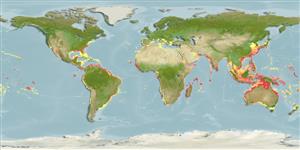Common names from other countries
Issue
Date and spelling Smith-Vaniz, pers. comm.
Environment: milieu / climate zone / depth range / distribution range
Sinh thái học
Biển Cùng sống ở rạn san hô; Mức độ sâu 0 - 150 m (Ref. 9710), usually 2 - 10 m (Ref. 40849). Subtropical; 44°N - 41°S, 180°W - 180°E
Western Atlantic: Massachusetts, USA and northern Gulf of Mexico to Rio de Janeiro, Brazil (Ref. 57756). Eastern Atlantic: off Genoa, Italy in the Mediterranean (Ref. 4233) and from Côte d'Ivoire to Angola (Ref. 7097). Throughout the Indo-Pacific (Ref. 37816), but rare or absent in the Persian Gulf (Ref. 3287). Eastern Pacific: mouth of Gulf of California to Ecuador; including the Galapagos Islands (Ref. 9283).
Length at first maturity / Bộ gần gũi / Khối lượng (Trọng lượng) / Age
Maturity: Lm 64.6 range ? - ? cm
Max length : 180 cm TL con đực/không giới tính; (Ref. 26340); common length : 90.0 cm TL con đực/không giới tính; (Ref. 5217); Khối lượng cực đại được công bố: 46.2 kg (Ref. 40637); Tuổi cực đại được báo cáo: 6 các năm (Ref. 96992)
Các tia vây lưng cứng (tổng cộng) : 7; Các vây lưng mềm (tổng cộng) : 25 - 30; Tia cứng vây hậu môn: 2; Tia mềm vây hậu môn: 18 - 22; Động vật có xương sống: 24. This species is distinguished by the following characters: the upper jaw ending distinctly before eye (and to below anterior margin of eye in young); dorsal fin with a detached terminal 2-rayed finlet; anal fin with a slightly detached spine from the rest of fin and covered by skin in fish of larger sizes, then followed by a second spine continuous with the 18-22 soft rays, including a detached 2-rayed finlet. Colour dark olive-blue or green dorsally and on side, white ventrally with 2 narrow light blue or bluish white stripes along sides and a broader olive or yellowish stripe between them; fins olive or yellowish (Ref. 9894,90102).
Adults are found in oceanic and coastal waters, generally near the surface over reefs or sometimes far from the coast often around floating logs or other debris (Ref. 9283, 11230, 48635, 90102). May form large schools (Ref. 9283, 48635). They feed on invertebrates, mainly on larger crustaceans of the zooplankton, and small fishes (Ref. 9283, 26145). Eggs are pelagic (Ref. 4233). Good food fish (Ref. 9626) and a valued game fish (Ref. 26938); marketed fresh and salted or dried (Ref. 9283); also frozen and used for sashimi (Ref. 9987).
Smith-Vaniz, W.F., 1986. Carangidae. p. 638-661. In M.M. Smith and P.C. Heemstra (eds.) Smiths' sea fishes. Springer-Verlag, Berlin. (Ref. 3197)
IUCN Red List Status (Ref. 130435)
CITES (Ref. 128078)
Not Evaluated
Threat to humans
Reports of ciguatera poisoning (Ref. 30911)
Human uses
Các nghề cá: tính thương mại cao; cá để chơi: đúng
Các công cụ
Warning: mysqli::__construct(): (HY000/1040): Too many connections in /var/www/html/includes/speciessummary.lib.php on line 2104
Can't connect to MySQL database fbquizv2. Errorcode: Too many connections
